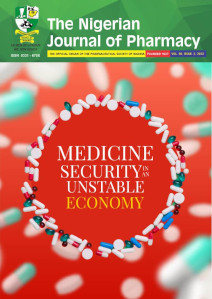The Assessment of Telepharmacy Practice Among Community Pharmacists in Lagos, Nigeria
https://doi.org/10.51412/psnnjp.2022.39
Keywords:
Community Pharmacy, Pharmacy Practice, Online Pharmacy, TelepharmacyAbstract
Background: Telehealth is transmitting medical information and providing and supporting clinical care from one place to another through electronic communication methods. Telepharmacy is the provision of pharmaceutical care to patients using technologies and telecommunications. Telepharmacy allows the pharmacist to provide patient care services in an area by taking history,
reviewing patients' files, and assessing medications utilized by the patients. This study is aimed to analyse the assessment of tele-pharmacy practice among community pharmacists in Lagos, Nigeria.
Methods: This was a cross-sectional descriptive survey of community pharmacists practising in Lagos, Nigeria. We used a convenient sampling technique in recruiting participants to the study. The questionnaire was developed and validated. The final questionnaire consisted of three sections. The first domain centered on the sociodemographic characteristics of the respondents while the second section probed for awareness and availability of telepharmacy services in community pharmacies in
Lagos.
Results: From our results54(63%) of the total pharmacy providers who were randomly sampled for this pilot study were currently practicing telepharmacy services in Lagos state, 82(96.5%) of the total participants were aware and had the perception on the importance of telepharmacy practice in Nigeria. Also, 21(50.7%) of the telepharmacy providers started the practice within 1-5years hence buttressing the fact that there is a surge in telepharmacy growth from the COVID-19 era till present. From the results 43(50.6%) of the participants strongly agree that telepharmacy practice enables greater penetration of the pharmaceutical market, 37(43.5%) also agree that telepharmacy is more convenient for their patient and 31(36.5%) also strongly agree that telepharmacy is an effective means of discharging pharmaceutical services.
Conclusion: Findings from the study show that most of the pharmacists practicing in Lagos were aware of the importance of telepharmacy practice and were also currently practicing telepharmacy, with also a more significant percentage of unaware pharmacists willing to practice telepharmacy. It was surmised that telepharmacy practice enables greater penetration of the pharmaceutical market, more convenient for the patients and is an effective means of offering pharmaceutical services.
Telepharmacy faced some challenges, including poor internet connectivity, poor patronage, high installation cost, and lack of ICT resources, possibly leading to more telephone interviews than videoconferencing.
References
Achenbach SJ (2020) Telemedicine: benefits, challenges, and its great potential. Health Law and Policy Brief 14(1):1-14.
Rogers H, Madathil KC, Agnisarman S, Narasimha S, Ashok A, Nair A (2017) A systematic review of the implementation
challenges of telemedicine systems in ambulances. Telemedicine Journal of e-Health 23(9):707-17.
Kane-Gill SL, Rincon F (2019) Expansion of telemedicine services: telepharmacy, telestroke, teledialysis, tele–emergency medicine. Critical Care Clinics 35(3):519-33.
WHO (2010) Telemedicine: Opportunities and Developments in Member States: Report on the Second Global Survey on eHealth. Geneva, Switzerland: World Health Organization.
Dorsey ER, Topol EJ (2016) State of telehealth. New England Journal of Medicine 375 (2) : 1 5 4 – 1 6 1 https//doi.org/10.1056/NEJMra1601705
Vecchione A (2016) Connected: telepharmacy unites the team. Drug Topics: Voice of the Pharmacist. North Olmsted, OH: Modern
M e d i c i n e N e t w o r k http://drugtopics.modernmedicine.com/drugtopics/news/connected
George LA, Cross RK (2020) Remote monitoring and telemedicine in IBD: are we there yet? Current Gastroenterology Reports
(3):1–6 https//doi.org/10.1007/s11894-020- 0751-0
Le T, Toscani M, Colaizzi J (2020) Telepharmacy: a new paradigm for our profession. Journal of Pharmacy Practice 33(2):176–182
Ahmed N, Saeed A (2020) Pharmacists knowledge and contribution during coronavirusdisease-2019 pandemic in Sudan, Matrix Science Medica 2021;5:31.
World Population Review. Lagos Population 2021 (Demographics, Maps, Graphs); 2021. https://worldpopulationreview.com/worldcities/lagos-population. [Last accessed on 2022 Jan 14]
Nigeria Centre for Disease Control. Covid-19 Nigeria; 2022. https://covid19.ncdc.gov.ng/. [Last accessed on 2022 Jan 14]
M o u l a e i K . , S h a n b e h z a d e h , M . , Bahaadinbeigy, K (2022) Survey of the patients' perspectives and preferences in adopting
telepharmacy versus in-person visits to the pharmacy: a feasibility study during the COVID-19 pandemic. BMC Med Inform D e c i s i o n M a k i n g 2 2 , 99.https://doi.org/10.1186/s12911-022-01834-5
Muflih SM, Al-Azzam S, Abuhammad S,Jaradat SK, Karasneh R, Shawaqfeh MS (2020) Pharmacists' experience, competence and perception of telepharmacy technology in response to COVID-19. International Journal Clinical Practice 75(4):1-9.
Anthony Jnr B (2021) Integrating telemedicine to support digital health care for the management of COVID-19 pandemic. International Journal Healthcare Management 14(1):280–9.
Ameri A, Salmanizadeh F, Bahaadinbeigy K. (2020) Tele-pharmacy: a new opportunity for consultation during the COVID-19 pandemic.
Health Policy Technology 9(3):281–2.
Justice E.O (2012) E-Healthcare/TelemedicineReadiness Assessment of Some Selected States in Western Nigeria. International Journal of Engineering and Technology 2. 2: 41-47.
Adewale O. S (2004) An internet-based telemedicine system in Nigeria. International Journal of Information Management, 24:221-
Banjoko S.O. and Omoleke, I.A (2008) Knowledge and Perception of Telemedicine and Ehealth by Some Nigerian Health Care Practitioners. International journal of science research, 4: 17-22.
Views | PDF Downloads:
1474
/ 612
/ 0
Published
How to Cite
Issue
Section
License

This work is licensed under a Creative Commons Attribution-NonCommercial 4.0 International License.



